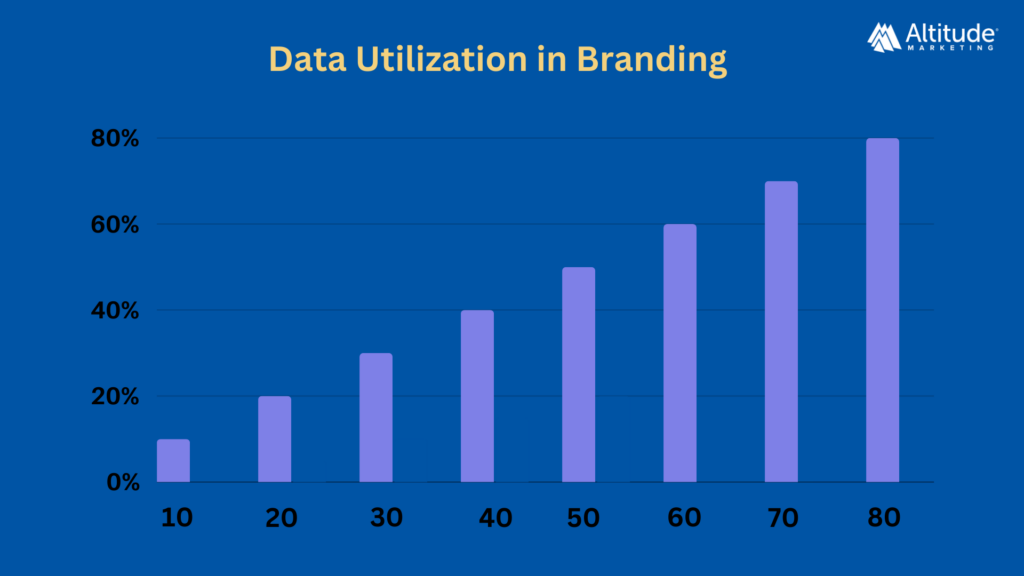Note: This blog was updated October 2024.
Your B2B brand is much more than just a logo and website. It’s a combination of those visual aspects with other verbal and emotional attributes that define the heart of your company and set you apart from your competition. This list of B2B branding trends will help you reinforce your position in the industry, drive a positive first impression, and help buyers take action.
B2B branding isn’t a once-and-done task — it’s something that needs to be continuously reinforced and sustained. Great branding can bring a lot to your organization, so this list of B2B branding trends will help you establish and bring your brand to life as you progress.

11 B2B Branding Trends
#1 — Stick to the Science
B2B branding isn’t just a creative discussion — it’s a scholarly one as well. There is a real science to brand-building and knowing how to appeal to your target audience.
Knowing your target audience is the first step (and usually starts with creating a B2B buyer persona). Some key categories you can use to paint a good picture of your target buyer:
- Age
- Role/Title (Are they a decision maker?)
- Behaviors (How do they interact with their team?)
- Priorities (What do they care about?)
Your target audience should always be a factor when creating anything for your brand, whether it be a piece of content or a logo. How will your branding appeal to this audience? How can you improve something to make it more centered around this audience? These are questions you should ask yourself when your B2B brand is new and when you have several successful years behind you – because there is always room for improvement.
#2 — User-Focused Branding
Yes, your brand is about you — but it’s really about your users. While your B2B brand should reflect who you are, it should also be designed with your users in mind. You can’t lose focus on the people who will be using your products and services because, without their interest, you wouldn’t have a business.
The user experience (UX) is a vital component of any brand and will either raise or lower brand value. If buyers have a positive experience with your brand online, they are more likely to revisit again for your products, services, and other offerings. Remember, it’s not about what you want; it’s about what your buyers want.
#3 — Sustainability
Problems like climate change and global warming have grown from niche to mainstream concerns. These days, many brands are taking the time to incorporate sustainable products and packaging, and this will continue to grow in 2024.
While prioritizing our planet is trending, this should be a lifestyle for all companies. Anything you do to lessen your environmental footprint is a win, and you should highlight this in your branding.
Implementing more ethical business practices, products and services is a great way to show your buyers that you truly care about their overall wellbeing and the health of the environment. This should be a vital part of your B2B brand and you can proudly talk about it on your website, social media channels, and wherever else you see fit. Buyers may be more inclined to support your business when they know that you care about the environment.
#4 — Data-Driven Branding
Data-driven branding is all about using data to see what your target audience responds to – and then doubling down on what’s working in your branding efforts.
With modern digital tools supporting you, you are creating a vast amount of data every single day.
Take a look at your top-trafficked website pages and high-performing social media posts. What messages or visuals resonate with your audience?

#5 — Immersive Branding
If branding is all about bringing your company’s position and offering to life, then immersive branding takes that to an entirely new level.
In general, this means creating an illusory environment for buyers so they can explore your brand with their senses. There are three ways to incorporate this into your brand.
- Using physical spaces — You can use your physical office or another space to bring your brand to life with technology. This could be as easy as reinventing your workplace to reflect your brand, or as complex as buying ad space at Times Square and creating a strategic branding video to display. It’s totally up to you and your branding capacity.
- Using virtual spaces — Bring your brand to buyers using virtual reality (VR), or use your website and social media platforms to do this. These spaces allow for limitless creativity. You could create a VR video that introduces your brand and products to buyers, while virtually walking through your office. You could host interviews on relevant topics that are reflected in your brand and post them on social channels. Once again, there is no limit to what you can create here.
- Using emotional experience — Appealing to a buyer’s emotional side can further their interest in your brand. A great example is Spotify’s “wrapped” creation — they put together a playlist at the end of the year that includes all the top songs that a user listed during that time frame. This promotes their platform while giving something personalized to every user.
#6 — Brand Activism
Every B2B brand has beliefs and values that helped shape it. Buyers like to know they are supporting brands that have values similar to their own, so showcasing some of yours into your brand can definitely be beneficial. This doesn’t have to be a huge effort — it can be as simple as creating a section on your website on the “About Us” page that briefly touches on some values and organizations that you support. Maybe you donate to the American Cancer Society, or you support women’s rights across the country — no matter what you support, being open and honest can help set your brand apart and attract your target audience.
#7 — Inclusivity & Diversity
The demand for inclusivity and diversity is consistently growing, and it isn’t hard to incorporate into your brand — all you really need to do is include and embrace people from different walks of life that many audiences can relate to.
For example, if you are making a commercial about your product, make sure to include people of different races, genders and bodily capabilities. People are always more likely to spend money on something if it is sold by someone who they can empathize with.
#8 — Branding Without Your Name
Buyers get tired of brands shoving their names into every single campaign. Repeating the same phrases and words can get tiresome and comes across as too sales-y.
The best brand messaging is the messaging that tells a clear, compelling story – that makes people think of your brand first without actually needing to see the name.
Of course, you need some general awareness before you can pull something like this off, but you can start using this tactic by focusing your headlines and ad creative on the story, minimizing your brand name or logo. Eventually, you may not need it at all.
#9 — Social Media Branding
Every aspect of your B2B company should be branded to reflect who you are and what you stand for — including social media. If your company is underutilizing social platforms, then 2025 is the year to change that.
You can start by finding the social networks that your target market uses the most, and then take the time to brand your profile and content accordingly. Remember, social media is another tool that you can use to inform and attract your audience, and it should align with the voice and language you use in the rest of your brand.
#10 — Future-Focused Branding
A lot of trends come and go (think NFTs and Crypto). When a fad overtakes an industry, take pause before you incorporate that fad into your brand. Rushed, uninformed marketing activities can actually tarnish your brand’s image.
It’s more important than ever to think about the future and how the decisions you make today will impact your brand in the next few years. Market research and competitor analyses are the tools that will keep you moving in the right direction.
#11 - AI and Automation in Branding
Businesses are using AI and automation more and more to boost personalization and efficiency in their branding. Technologies such as machine learning and natural language processing can sift through large amounts of consumer data to reveal valuable insights about preferences, behaviors, and sentiments. This information can then be used to customize branding messages, visuals, and interactions for specific audiences or even individual customers.
One way AI can be used is by examining a company’s social media interactions, customer feedback, and website traffic to understand what types of messaging, visuals, and content topics appeal most to various customer groups. This information can be used to customize website content, email campaigns, and advertising materials for a more individualized brand experience.
AI can also automate many time-consuming tasks involved in coordinating a consistent brand identity across multiple channels and customer touchpoints. Chatbots and virtual assistants utilizing natural language understanding can provide on-brand conversations and self-service information tailored to each customer’s context.
As AI capabilities advance, we’ll likely see branding become increasingly adaptive, automated, and hyper-personalized to meet rising customer expectations for relevant, seamless experiences from the brands they engage with.
Final Thoughts
With the right B2B branding recipe, there is nothing you can’t do. Following these B2B branding trends will not only keep your brand up to date but also ensure that you are attracting buyers in the best, most authentic way possible. 2024 is your year — use these B2B branding trends to drive your success.
FAQs
What is branding in B2B?
Branding in B2B refers to creating a distinct identity, image, and reputation for a company that sells products or services to other businesses.
What are the 4 types of B2B marketing?
The 4 main types of B2B marketing are product marketing, service marketing, solution marketing, and company marketing.
What are the 4 pillars of B2B marketing?
The 4 pillars of B2B marketing are thought leadership, lead generation, sales enablement, and customer marketing.



